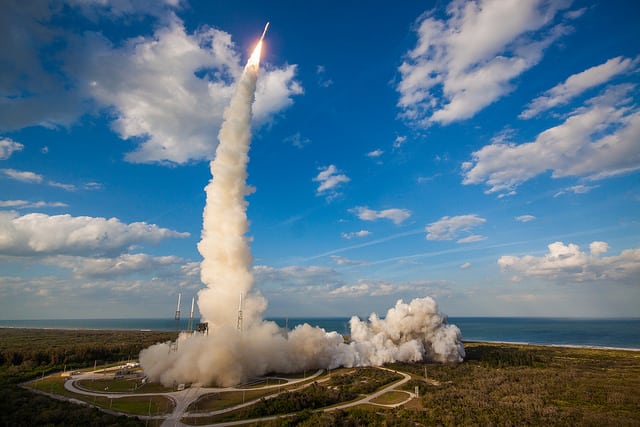Latest News

A ULA Atlas 5 rocket launches the GOES S satellite on March 1, 2018. Photo: ULA.
NASA and United Launch Alliance (ULA) successfully launched the second in a series of next-generation weather satellites this week for the National Oceanic and Atmospheric Administration (NOAA). At 5:02 p.m. EST Thursday, NOAA’s Geostationary Operational Environmental Satellite-S (GOES S) lifted off on an Atlas 5 rocket from Space Launch Complex 41 at Cape Canaveral Air Force Station in Florida.
GOES S mission managers confirmed at 8:58 p.m. EST the spacecraft’s solar arrays successfully deployed and the spacecraft was operating on its own power.
Once GOES S is positioned in a Geostationary Earth Orbit (GEO) 22,300 miles above Earth in approximately two weeks, it will be renamed GOES 17. Later this year, after undergoing a full checkout and validation of its six high-tech instruments, the new satellite will move to the GOES-West position and become operational. From there, it will provide faster, more accurate and more detailed data, in near real-time, to track storm systems, lightning, wildfires, coastal fog and other hazards that affect the western United States, according to NASA.
In addition to improving weather forecasts, GOES 17 will help forecasters locate and track wildfires — invaluable information that emergency response teams need to fight fires and evacuate people out of harm’s way. GOES 17 also will be an important tool for forecasters to track and predict the formation and dissipation of fog, which can disrupt airport operations.
GOES 17 will work in tandem with GOES 16, the first satellite in NOAA’s new GEO series, now at the GOES-East position. GOES 17 will extend observational high-resolution satellite coverage of the revolutionary new technology aboard GOES 16 to most of the Western Hemisphere, from the west coast of Africa to New Zealand, and from near the Arctic Circle to near the Antarctic Circle. The satellite will provide more and better data than is currently available over the northeastern Pacific Ocean, the birthplace of many weather systems that affect the continental U.S., according to NOAA.
NOAA manages the GOES-R Series program through an integrated NOAA/NASA office at NASA’s Goddard Space Flight Center in Greenbelt, Maryland. NASA also oversees the acquisition of the spacecraft, instruments and launch vehicles. NOAA will perform mission operations at its Satellite Operations Facility in Suitland, Maryland.
Lockheed Martin built the spacecraft and is responsible for spacecraft development, integration and testing. Harris of Melbourne, Florida, provided the main instrument payload, the Advanced Baseline Imager (ABI), and the ground system, which includes the antenna system for data receipt. NASA’s Launch Services Program, based at the agency’s Kennedy Space Center in Florida, is responsible for launch management.
“GOES S increases the coverage of our nation and will contribute to the quality and timeliness of weather data — but it is also more than that.” said Tim Gasparrini, GOES R vice president and program manager at Lockheed Martin Space. “As is evident with the performance of GOES 16 on orbit, we are gaining insight into our weather like never before. The extended application of this data is expected to have a large impact on industries like shipping and logistics, aviation, transportation and more.”
Get the latest Via Satellite news!
Subscribe Now